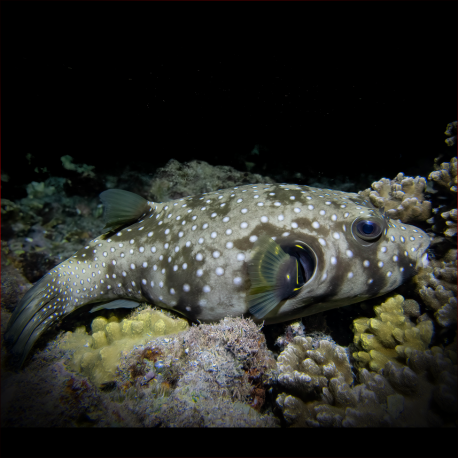More info
Datasheet
| Minimum Tank Size | 2000 litres / 528.34 US gallons |
| Maximum Size | 50.0cm / 19.69inches |
| Reef Compatible | Not reef safe |
| Temperament | Mostly peaceful but might be aggressive towards similar species |
| Temperature | 22.2°C / 71.96°F - 25.6°C / 78.08°F |
| Specific Gravity | 1.020-1.025 |
| Carbonate Hardness | 8-12 |
| pH | 8.1-8.4 |
General Description
The White-spotted puffer (Arothron hispidus), also known as the Stars and Stripes puffer, is a species belonging to the Tetraodontidae family. These pufferfish are characterized by their unique swimming style, interesting personality, and their ability to puff up when threatened. They are native to the waters of the East Indian Ocean, West Indian Ocean, Australia, The Red Sea, Indonesia, East Pacific, New Zealand, and the Central/West Pacific, with a distribution spanning from the Red Sea and East Africa to Panama, stretching from southern Japan to the Hawaiian Islands.
Aquarium Suitability
Considered suitable with care, the White-spotted puffer is known for its hardy nature but requires specific attention due to its demands. These fish have a somewhat peaceful temperament, although they may display aggression towards similar species. It is important to note that they are not reef-safe due to their tendency to feed on invertebrates like shrimp, crayfish, crabs, and sea urchins. Care must be taken not to expose them to air, as they struggle to expel it and can release a toxic substance from their skin when stressed or dying, resulting in a threat to other aquatic life in the aquarium.
Demands, Care, and Hardiness
Requiring a minimum tank size of 2000 liters, these pufferfish demand a diet that includes larger crustaceans, invertebrates, and small crustaceans such as krill and artemia. Regular feeding is crucial to prevent dental issues, as their teeth continue to grow throughout their life. Maintaining water conditions with a temperature range of 22.2-25.6°C, pH of 8.1-8.4, and specific gravity between 1.020-1.025 is essential for their well-being. Handling and transporting them should be done cautiously to prevent accidental puffing, which may lead to difficulties in breathing.
Reef Suitability
Due to their feeding habits and the potential threat they pose to various invertebrates, the White-spotted puffer is not considered safe for reef environments. They may nibble on the fins of other fish and are best kept in fish-only tanks where their dietary requirements can be met without risking the delicate balance of a reef ecosystem.
Aquarium Setup
Setting up an aquarium for White-spotted puffers should include ample space for swimming and hiding spots. It is advisable to include sturdy decor and rocks to create caves and crevices for exploration. Due to their potential aggression towards similar species, careful consideration should be given to tank mates. Regular monitoring of water quality and filtration to handle the demands of their diet is necessary for maintaining a healthy environment.
Behaviour
White-spotted puffers are known for their playful and entertaining personalities. They exhibit curious behavior, occasionally blowing water onto sand, reminiscent of their natural feeding habits. Additionally, they may spray water out of the tank, a behavior to consider when siting electrical equipment in the aquarium.
Feeding and Diet
Their diet should consist of foods that aid in keeping their teeth trimmed, such as clams, snails, and mussels. While they may eat flake foods, it is essential to supplement their diet with a variety of seafood and frozen fare to ensure proper nutrition. When selecting pufferfish from a store, it is crucial to be mindful of potential parasites and promptly address any signs of illness through quarantine and treatment.
Habitat and Distribution
In their natural habitat, White-spotted puffers can be found in Indo-Pacific waters ranging from the Red Sea and East Africa to Panama, with northern boundaries extending to southern Japan and the Hawaiian Islands, and southern boundaries to Lord Howe and Rapa islands. They are also present in the Eastern Pacific region from Baja California and the Gulf of California to Panama. Their habitat preferences include areas with adequate shelter and access to a variety of prey items, reflecting their omnivorous feeding habits.

